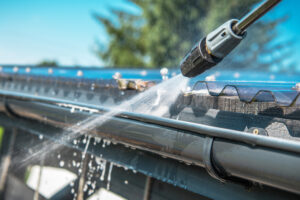How to Clean Gutters

*Updated June 27th, 2025
Properly cleaning your gutters is a crucial task that ensures your home remains protected from costly water damage. Your gutter system plays a vital role in directing rainwater and melted snow away from your roof, walls, and foundation, safeguarding the structural integrity of your property. When gutters are clogged with leaves, twigs, and gutter debris, they can overflow, causing water to pool on your roof, seep into your walls, or erode your home’s foundation. Neglecting this essential home maintenance can lead to issues such as mold growth, basement flooding, and expensive repairs.
In this guide, we’ll walk you through everything you need to know about gutter cleaning, including step-by-step tips, the tools you’ll need, and safety precautions to take. We’ll also explain why, in some cases, it might be wise to hire a professional. While cleaning out gutters can be a manageable DIY project, professional gutter cleaning ensures the job is done safely and thoroughly—especially for multi-story homes or hard-to-reach areas. Keep reading to learn how to clean gutters and prevent future damage to your home.
5 Reasons You Must Clean Your Gutters
It’s a dreaded chore, but cleaning your gutters is essential for many reasons. So if you’ve thought about skipping this important fall task, here are five reasons not to.
1. Prevent Water Damage
Gutters are meant to drain water and keep it away from your house. However, if the gutters are clogged with leaves and other debris, water can’t drain properly, causing leaks into your windows or foundation. This puts your home at risk for water damage, mold growth, and standing water around your foundation.
2. Protect Your Roof
Gutters also protect your roof by directing water away from it. When gutters are clogged, water sits on your roof, increasing the risk of leaks and damage. This can lead to needing a premature roof replacement.
3. Avoid Pest Infestation
Debris-filled gutters attract rodents and insects. Nests and burrowing in your home’s gutters can add weight and stress, leading to sagging gutters or other gutter system failures.
4. Prevent a Cracked Foundation
Pooling water around your foundation can cause cracks. Clean, functional gutters and downspouts ensure water flows toward the downspout and away from the home.
5. Reduce Unnecessary Expenses
When gutters don’t function properly, you’ll likely face larger repair bills. Keeping your gutters clean protects multiple areas of your home and prevents costly fixes.
6. Prevent Ice Dams in Winter
Clogged gutters trap water, which can freeze into damaging ice dams. A thorough cleaning ensures water can flow freely, reducing wintertime risks.
7. Extend the Lifespan of Your Gutters
Gutters filled with debris can sag or crack. Routine gutter maintenance helps prevent early deterioration and avoids the need to replace gutters prematurely.
8. Prevent Landscaping Erosion
Overflowing gutters can destroy your landscaping. Cleaning ensures proper water flow into safe drainage zones instead of your flower beds or lawn.
9. Improve Curb Appeal
Sagging gutters, visible clogs, or stains diminish your home’s appearance. Cleaning out gutters regularly keeps the exterior of your home looking polished.
10. Prevent Basement Flooding
When gutters overflow, water can pool near your basement walls and leak inside. Clean gutters and downspouts protect against flooding and structural issues.
11. Protect Exterior Paint and Siding
Water running down clogged gutters can damage your paint and siding. Regular cleaning helps you avoid peeling paint, tile damage, and leaks at the seams.
What is the Best Way to Clean Gutters?
Before you start, it’s important to know the safest and most effective way to clean your gutters. You can clean gutters without a ladder, or you can use a ladder for a hands-on approach.
1. Garden Hose Gutter Cleaning from the Ground
You can clean gutters from the ground using a garden hose and a special gutter cleaning attachment. Spray water through the gutter using a nozzle to dislodge debris, working from top to bottom. This is a safer option if you want to avoid using a ladder.
2. Wet/Dry Vac Gutter Cleaning from the Ground
A gutter vacuum is another excellent option to clean gutters without a ladder. Use a shop vac with a blower tube or attachment to suck out leaves and dirt. Be careful not to clog the vacuum hose with large debris.
3. Clean Gutters with a Leaf Blower from a Ladder
If you feel comfortable climbing a ladder, you can clean out your gutters using a leaf blower. Block the downspout, blow debris out, and then flush the gutters with water. Use blower attachments designed for gutter cleaning to make the job easier.
4. Power Washer Gutter Cleaning from a Ladder
If the gutters are heavily blocked, consider pressure washing them. Use a pressure washer with a fine nozzle and keep the setting at high pressure to effectively remove stuck-on grime and twigs.
Can You Clean Gutters by Hand?
Absolutely. Cleaning gutters by hand requires a ladder, gloves, and a bucket. Scoop out gutter debris, then rinse with a garden hose. Be sure to avoid stepping on the roof or overreaching.
Is It Worth It to Clean Gutters Yourself?
While you can learn how to clean gutters with basic tools, it can be risky. Climbing a ladder is dangerous, especially without someone to stabilize it. Mistakes in cleaning can also lead to damage to your home.
For safety and thoroughness, it’s often better to hire a professional. A gutter cleaning service has the tools, training, and insurance to handle the task efficiently.
Safety Measures When Using a Ladder to Clean Gutters
If you decide to clean your gutters yourself:
-
Wear gloves and safety goggles
-
Never use a step ladder
-
Only use a ladder if someone else is present
-
Don’t overreach—reach and clean only what’s safely accessible
-
Place a drop cloth to catch debris
How to Prevent Clogged Gutters
Even if you clean your gutters regularly, preventive measures can reduce the need for frequent cleanings.
Install Gutter Guards
Install gutter guards to keep large debris like leaves and twigs out of your gutters while allowing water to pass through. They help reduce buildup, though some debris may still slip through.
Trim Trees and Bushes
Branches can drop leaves or break off and clog rain gutters. Keep vegetation trimmed to protect the gutter system.
Inspect Your Roof Annually
Loose shingles or roof debris often end up inside your gutters. An annual inspection prevents this.
Avoid Airborne Debris
Keep garbage bins covered and yard items secured during storms to minimize windblown debris entering your gutters.
How Often Should You Clean Your Gutters?
You should clean your gutters at least twice a year, ideally in the spring and fall.
-
Fall: Clear out leaves, sticks, and gutter debris before winter.
-
Spring: Remove pollen, blossoms, and seed buildup.
-
After storms: Inspect and flush the gutters to maintain proper water flow.
Even with gutter guards, annual cleanings or inspections are still necessary.
Final Thoughts
While you may be tempted to tackle cleaning out gutters on your own, hiring a professional gutter cleaning company often saves time, risk, and frustration. They’ll also check for signs of wear and tear—like sagging gutters, gutter sealant failure, or misaligned downspouts.
By scheduling routine cleanings, you protect your home from water damage, maintain a clean gutter system, and avoid costly issues like leaks at the seams or erosion from poorly managed runoff.
FAQ
How do you clean gutters when you can’t reach them?
You can clean gutters without a ladder by using a garden hose, wet/dry vac, or gutter vacuum with the right attachments. If those aren’t an option, hire a professional.
Is it normal for water to stay in the gutter?
No. Standing water is a sign of a clogged gutter or improper slope. Your gutter system should always allow water to flow toward the downspout.
How do you tell if your gutters are clogged?
-
Overflowing water
-
Visible plant growth in the gutter
-
Water stains on siding
-
Sagging gutters
Additional Gutter Resources
- How to Install and Replace Gutters
- DIY vs Professional Gutter Installation
- Rain Gutter Alternatives for Your Home
- Gutter FAQs

Anna has over six years of experience in the home services and journalism industries and serves as the Content Manager at MyHomePros.com, specializing in making complex home improvement topics like HVAC, roofing, and plumbing accessible to all. With a bachelor’s degree in journalism from Auburn University, she excels in crafting localized, comprehensive guides that cater to homeowners’ unique needs. Living on both coasts of the United States has equipped her with a distinctive perspective, fueling her passion for turning any house into a cherished home through informed, personalized decision-making.








